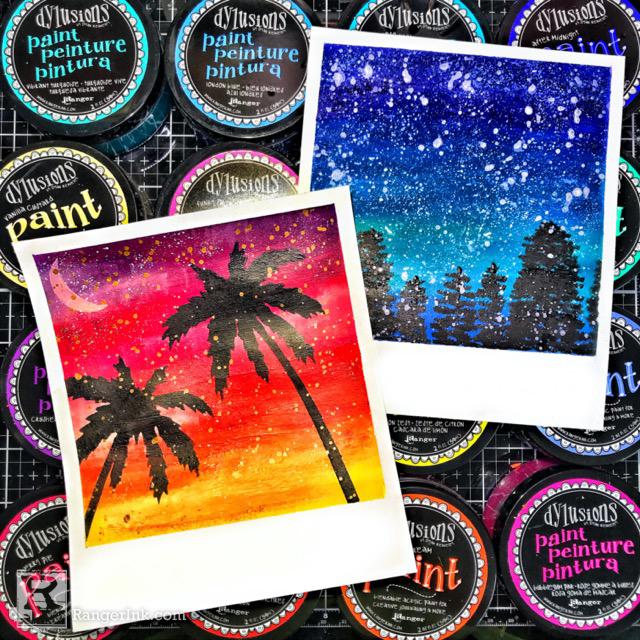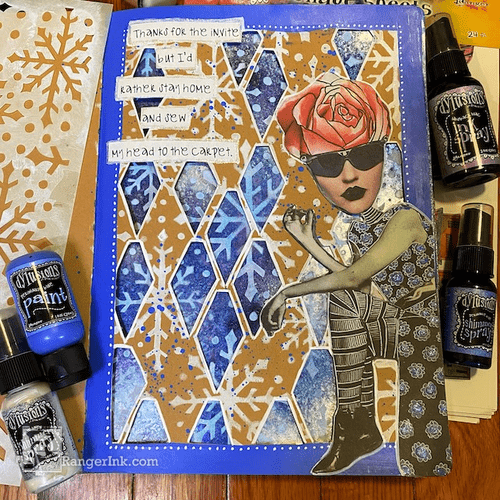Create "picture perfect" works of mixed media art with this easy to follow tutorial by Renae Davis. Learn how you can make your own scenic polaroids by using Dylusions Paints on Simon Hurley create. Stark White Cardstock.

Painted Polaroids by Renae Davis
- Materials
- Instructions
Instructions
Polaroid photos will forever be a nostalgic favorite for many people. The square interface that provided instant gratification of capturing a candid moment in time. In this project, we’re going to paint some vibrant scenery images in the shape of a polaroid template that can be used however you like. It’s a great way to record images of places you’ve been or have never been and want to or scenes that may not even exist yet except in your own fantastical world.

Step 1: Trim one piece of 8.5” x11” Simon Hurley Stark White Card stock in half to have two identical sheets sized at 5.5” x 6.5”. The 6.5” will be the vertical side for the template.

Step 2: Measuring 1/4” from the right, top, and left side of the template, draw a light pencil line from edge to edge for each side. Measuring 1-1/4” from the bottom, draw a light pencil line from edge to edge.
There should be a penciled square measuring 5” on each side in the almost middle of the paper. Check to make sure the lines are even and measured correctly.

Step 3: Using painter’s tape or masking tape, place down the edges of the tape on top of the pencil lines. Press firmly on the edges of the square to provide a secure seal.
TIP: To prevent possible ripping of the paper upon removal, stick the tape stripes to a piece of clothing or carpet to relieve some of the stickiness of the adhesive. Some tapes can be very aggressive when it comes to sticking to delicate surfaces.

Step 4: Using a palette knife (if using the Dylusions jars), lay down a drop of paint in the following order from top to bottom: Crushed Grape, Cherry Pie, Bubblegum Pink, Postbox Red, Tangerine Dream, Pure Sunshine, Lemon Zest.

Step 5: Starting from the bottom at Lemon Zest, blend each layer together in a left to right swiping motion all the way to the top and then repeat all the way to the bottom. This will not only blend each color but it will provide hints of each color on each layer making for a more seamless sunset and maybe even a cloudy look. If there is too much paint within the square, wipe the excess on a scrap piece of paper and continue blending.

Step 6: Using Black Marble, paint a silhouette of a palm tree (or whatever you choose). If you don't feel confident in your painting abilities, use a stamp or a stencil or even print one from the internet. Behind the trees, I also faintly added some clouds and a moon using a sponger dabber with Dylusions Acrylic in Vanilla Custard.

Step 7: Dilute Dina Wakley’s Gilt acrylic paint using a Distress Sprayer filled with water and add splashes all over the scene.

Step 8: Once the paint is dry, carefully remove the painter’s tape in a downward motion pulling away from the painted square. Erase any stray pencil marks and paint over any stray paint marks with White Linen. If your page happens to tear from the tape, you can always use a file to sand way the rough edges.
The first polaroid is complete!

Step 9: On the second template, repeat steps three and four. Using a palette knife (if using the Dylusions jars), lay down a drop of paint in the following order from top to bottom: After Midnight, Calypso Teal, London Blue, Polished Jade, Vibrant Turquoise, Periwinkle Blue.

Step 10: Starting from the bottom at Periwinkle Blue, blend each layer together in a left to right swiping motion all the way to the top and then repeat all the way to the bottom as done with the other template.

Step 11: Dilute White Linen Acrylic Paint using a Distress Sprayer filled with water and add splashes of white with a toothbrush (flick in a downward motion with your thumb) all over the page. Repeat this method with Dina Wakley Sterling acrylic paint and s small paint brush.

Step 12: Using the small flat brush and Black Marble Acrylic Paint, paint some wooded tress along the bottom of the page. Start by painting a thin line down the middle for the tree trunk and then turn the brush sideways dabbling left to right from top to bottom to create a tree. Once finished, remove the tape to reveal the second completed polaroid.

Display your creations! You can add them to an art journal or scrapbook layout, use them as a postcard or even display them on your wall using a string and some clips (or frame them if you’re fancy!). This is an easy way to start a small collection of mini paintings that might even make your friends and family guessing if you are a secret undercover traveling photographer. The space at the bottom of the template is a great place to share a quote, a memory, or the location of your scene. Happy traveling!
 Renae Davis.
Renae Davis.
Art Journaler. Photographer. Daydreamer.
Art journaling is my jam. I started out Bible Journaling a couple of years ago that has now evolved into 20+ active luscious art journals of all sorts, sizes, and themes. I love making my own recycled art supplies and using every bit of scrap paper and pigment that I can get my inky hands on. You can visit Renae's website at www.splendiferossity.com or follow her on Instagram @redhedtm and on YouTube.







